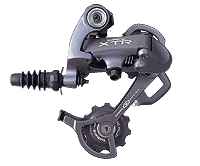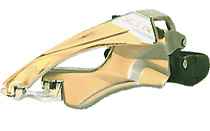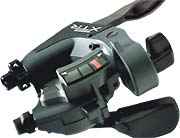
For the past several years, I have had 24-speed gearing on my road bike. Given that I like touring, given that I like mountains, given that I like to combine the two whenever possible, it only made sense that I want wide-ratio gearing, with of course, lots of close steps. My Richard Sachs had mostly XT components, with Bar-Con shifters. And it had half-step plus granny gearing.
Well, 27 speeds is now the standard. Shall I? From time to time, I checked the components, but they didnít make sense for me. Finally, the new XTR gruppo came out, a 24-34-46 crankset and a 12-34 9-speed cassette. That would give me a little more on the high end, a little less on the low end, and slightly smaller steps on average. Sounded like a win-win-win.
Unfortunately, there was no way I could fit it out with a half-step crank. The front derailleur was rated for a minimum of 12 teeth between the two larger chainrings. Well, if the steps are small enough, the half-step shouldnít matter Ė and truth be told, I donít use it all that often anyway.
By email, I enquired of several local bike shops. They didnít even deign to answer. Not only were they booked up into the next millennium, they were totally incompetent (thatís the really scary part!). The ones I talked to in person were, no way, no how, going to guarantee that what I wanted was even possible, much less would work well.
Then I started looking at prices! Gasp! XTR is one expensive gruppo. I shopped around on the internet and got a list of the things I needed for about $700 Ė about half what the local bike shops would have charged me. Maybe Iíll do it myself (said the little red hen). As well as avoiding a couple hundred dollars in labour charges, it will be an education. Frankford Bicycle and Colorado Cyclist had the best prices, but CC had a problem with their online ordering software. So I placed an order with Frankford.
One of the bike shops I had talked to said I could use Dura-Ace Bar-Con shifters with XTR, so I ordered a set of them, too. Otherwise, it was all XTR. That, and a few tools I would need, for example a cartridge bottom bracket tool from Park.

The box arrived. Beautiful parts! Half the cogs are titanium, the cranks are hollow-forged, even the bottom bracket is hollow. Thereís a reason this kit costs a bundle.
Iíve never done anything this ambitious before. I console myself with the thought that I can always put the old components back on the bike if needs be. Weíll see how it goes.
It was the weekend. I took a deep breath and plunged a stake through the heart of my beloved, trusty, old bike. Will it ever be rideable again?

The new bottom bracket wasnít bad. I had guessed, correctly, what a 50-mm chainline was. I smeared lots of Phil Wood grease on everything, one of the things I finally learned about bicycle assembly. The crankset was no problem. I left the pedals off Ė thatís for the very end of the process. Rear derailleur, cassette Ė again, no problem. I started feeling pretty good.
For the front derailleur, I had had a choice between top-pull and bottom-pull, and I hadnít understood the difference Ė so Iíd bought a top-pull derailleur. Oop! What that means is that the shifter cable is routed along the top tube and down the seat tube, rather than along the down tube and under the bottom bracket. Damn!
Frankford had a good returns policy, and I had been careful not to do anything irreversible to the derailleur. So getting the right derailleur should cost me nothing but time.
Just to see whether everything else was okay, I put the Bar-Con shifter on the right handlebar, cabled it up to the derailleur. But when I clicked past the stops, the idler pulley was nowhere near aligned with the cogs. And Shimanoís instruction sheet says Bar-Cons only work with the Dura-Ace derailleur. Damn!

I also noticed, once I had the spec sheets, that the XTR rear derailleur is only specified to work if the angle between the chainstay and the seat tube is between 66 and 69ļ. I measured mine Ė it was about 63, maybe even 62ļ. Damn!
Should I try for an Ultegra derailleur? Stopped at the local bike shop Ė one of the real turn-offs is bike shops that have kids at the counter who know a lot less about bikes than I. But I talked with a graybeard in the shop, who told me Ultegra was designed for a 52-tooth chainring, and if my largest chainring was 46, XTR would work better. Not to worry about the angle. ďJust throw away those Shimano instruction sheets!Ē
So I placed an internet order for a new XTR front derailleur and set of XTR shifters. I donít really want mountain-bike shifters on these handlebars, but if thatís the only way it will work, so be it. The bike people said I could ship the other stuff back any time.
A week later, another box arrived. It was Saturday again.

First I installed the front derailleur Ė no problem. I cabled it up to the old Bar-Con on the left handlebar. I didnít worry about changing the front shifter; friction shifting is just fine.
Now that I had the basic drivetrain in place, it was time for the chain. Shimano chains have a special reinforced pin to join the links, and there was none with the one I had bought. Damn!
Well, letís try the shifters. Actually only the rear shifter Ė Iíll worry about the front later, or never. Beautiful looking assemblies, even though they have gear position indicators, which strikes me as dumbing them down. The only problem is that their mounting clamps are cast right into the bodies, and the mounting clamps are for 7/8" handlebars, and my bike has 1" handlebars. Damn!

So I wedged the clamp open far enough to work the shifter onto the handlebars. Then the binder bolt wouldnít reach. I found a bolt with the right thread in the junk box, but it was too long. Time for a visit to the bike shop.
Yes, I could get an intermediate-length binder bolt. Yes, I could buy a reinforced pin for the chain. The guy suggested I should really get a 7/8" handlebar. Right! I donít even know whether they make 7/8" dropped handlebars. Assuming they do, then Iíd need new brake handles and a new stem, and then Iíd need a new headset, and thenÖ
With a bit of swearing, I secured the shifter assembly to the handlebars. Cabled up the rear derailleur, and Iím ready to try out the shifting. As I went across the stops, the idler pulley, once again, did not line up with the cogs. Since these components were engineered to work together, maybe the extra load of the chain affects the positioning. Letís find out!
In the past, Iíve always measured a new chain from the length of the old, but this was an opportunity to do it from scratch. The way it works is to wrap the chain around the largest rings, then add two teeth for the rear derailleur. Simple and effective.
Itís a real pleasure to see a perfectly-engineered piece of machinery in action. Click, click, click! Great! The shifts lined up perfectly. Adjusted the extreme travel screws, and I was in business. Time to put the pedals on!
Took the bike around the Portola Valley loop to check it out before taping the handlebar. Things worked well, but it was clear that I wanted the shifter as far inboard as it would go. And the brake handle, which I had had to remove, needed a bit of repositioning. No problem. Made the adjustments, taped the handlebar, and Iím done. Maybe.
Sunday I took it to Mt Hamilton. I have also been trying to get the brakes toed in, and need something vertical on which to check them out. Diablo, and even Page Mill, require 100% brakes, but Hamilton would tolerate maybe only 80% brakes, so itís a good place if you arenít completely confident about them.
The ride was fine, cool on the uphill and very nearly cold coming down (the temperature at the top was only 51ļ). What I had not appreciated was the extent to which the mountain bike shifter prevented me from comfortably riding with my hands on the horizontal part of the bar, just outboard from the computer. I could, indeed, rest my hand there, but I couldnít curl my fingers naturally. The diameter was wrong, and any pressure could cause an upshift; it was tiring having to hold my fingers open.
Speaking of shifting: it was beautiful. Nice bike! Unfortunately, my secret dream, of going twice as far, twice as fast, with half the effort and half the pain, still didnít come true. Not really a surprise, somehow.
Without a chain, the XTR shifter, like the Bar-Con, had not aligned with the cogs. But on the road, it shifted wonderfully. I wonder: do you suppose the Bar-Con would work after all? It would certainly be a better arrangement. Besides, thereís a serious lack of integrity with a Bar-Con on the left and a mountain-bike shifter on the right.
I hadnít yet shipped the old stuff backÖIt would be easy to conduct an experiment. I pulled the existing cable off the rear derailleur, assembled the Bar-Con loose in my lap, connected it to the bike with a piece of scrap cable through a bit of cable housing. The other interesting thing I discovered about the Bar-Con is that it has ten positions! Something to keep in mind for three years from nowÖ I shifted it through the stops, and it worked like a champ!
Too bad I didnít know that going in! Sigh! Well, there was no doubt what I was going to do, and I went ahead and did it. Off with the handlebar tape. Off with the XTR shifter. Sorry I spent the money on them, but theyíre clearly not returnable after the work I did to get them onto the larger handlebar. It was still a lot cheaper than letting the bike shop do it.
Installed the right Bar-Con; the colors didnít quite match, but I didnít see any need to mess with the left side, so I left it alone. Adjusted the shift pattern Ė it still works (whew!). Re-taped the handlebar. All this is interesting and educational, but Iím glad itís over Ė and it damn well better be over!
For those of us marching to different drummers, itís a challenge to make a tightly-engineered gruppo work in a different application, and one of these days, I suppose it will no longer be possible. On the other hand, it seems there ought to be a market for those of us who are wise enough (or old enough) not to push a 52/13. Maybe by the time this gruppo is ready for replacement, Iíll be looking at mainstream components instead of special adaptations.